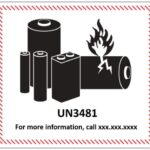Before we begin…
All of the following is based on the Hazardous Materials Regulations (HMR) of the Pipeline and Hazardous Materials Safety Administration within the U.S. Department of Transportation (USDOT/PHMSA).
Question (10.20.20):
You seem to have the most info and the most accurate info regarding highway transportation of hazmat. Recently I hauled this “modular power unit” from NM to NY. At the delivery point the job super asked why it wasn’t placarded, I told him I wasn’t tendered the load as hazmat, so I had no idea. He told me the unit was a battery backup for GE and contained 50,000 lbs of lithium ion batteries. Is that considered hazmat and was it supposed to be marked or placarded?
Daniels Training Services, Inc. 815.821.1550 |
Answer (10.20.20):
Thank you for the compliment. Good question. The answer depends on many factors. See below.
- This table indicates the regulatory thresholds for lithium battery “size”. It is necessary for the classification and transport of lithium batteries.
| Industry and EPA hazardous waste No. | Hazardous waste | Hazard code |
|---|---|---|
| F020 | Wastes (except wastewater and spent carbon from hydrogen chloride purification) from the production or manufacturing use (as a reactant, chemical intermediate, or component in a formulating process) of tri- or tetrachlorophenol, or of intermediates used to produce their pesticide derivatives. (This listing does not include wastes from the production of Hexachlorophene from highly purified 2,4,5-trichlorophenol.) | (H) |
| F021 | Wastes (except wastewater and spent carbon from hydrogen chloride purification) from the production or manufacturing use (as a reactant, chemical intermediate, or component in a formulating process) of pentachlorophenol, or of intermediates used to produce its derivatives | (H) |
| F022 | Wastes (except wastewater and spent carbon from hydrogen chloride purification) from the manufacturing use (as a reactant, chemical intermediate, or component in a formulating process) of tetra-, penta-, or hexachlorobenzenes under alkaline conditions | (H) |
| F023 | Wastes (except wastewater and spent carbon from hydrogen chloride purification) from the production of materials on equipment previously used for the production or manufacturing use (as a reactant, chemical intermediate, or component in a formulating process) of tri- and tetrachlorophenols. (This listing does not include wastes from equipment used only for the production or use of Hexachlorophene from highly purified 2,4,5-trichlorophenol.) | (H) |
| F026 | Wastes (except wastewater and spent carbon from hydrogen chloride purification) from the production of materials on equipment previously used for the manufacturing use (as a reactant, chemical intermediate, or component in a formulating process) of tetra-, penta-, or hexachlorobenzene under alkaline conditions | (H) |
| F027 | Discarded unused formulations containing tri-, tetra-, or pentachlorophenol or discarded unused formulations containing compounds derived from these chlorophenols. (This listing does not include formulations containing Hexachlorophene sythesized from prepurified 2,4,5-trichlorophenol as the sole component.) | (H) |
- If the lithium batteries met the criteria for “smaller” in the HMR i.e., less than 100 Watt/hour (Wh) for lithium ion or less than 2 grams of lithium metal for lithium metal battery, then it is (mostly) not subject to USDOT regulations when in transport. It would not be a “HazMat” load but each package containing a lithium battery would need to display the lithium battery mark. No other regulations would apply. Read: Classification of Lithium Batteries for Transportation in Commerce

- If the batteries were larger than indicated above (as I suspect they are), then they would be subject to full regulation as a “HazMat” shipment. However, even then it is not necessary to display placards on the vehicle.
Q: “Why is it not necessary to display placards on a vehicle transporting this quantity of lithium batteries?”
A: “Lithium batteries of all types, all configurations, and all quantities are a Class 9 Miscellaneous. The display of the Class 9 Miscellaneous placard is not required within the U.S. – though it remains an option.
Read: Is the CLASS 9 Placard Required?
- Further, since the vehicle is not required to display a placard, the driver is not required to have the HazMat endorsement on their CDL.
- However, if this is a fully-regulated HazMat shipment as I suspect, you should have been provided with a shipping paper describing the consignment and been given emergency response information and an emergency telephone. Also, you must receive HazMat Employee training.
- If you are able to provide more information about the batteries I can provide more specific information.
- At a minimum you should have HazMat Employee Training.
Please contact me with any other questions.
Contact me with any questions you may have about the transportation of lithium batteries by air, highway, vessel, or rail International and Domestic |
That did it!
The transportation of lithium batteries is essential and complicated. Make sure you comply with the Hazardous Materials Regulations of USDOT/PHMSA for any transportation to, from, or through the U.S.
